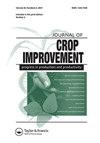Performance of three-way maize hybrids across different agro-ecologies
IF 1.5
Q3 AGRONOMY
引用次数: 3
Abstract
ABSTRACT The rising demand for maize (Zea mays L.) in West and Central Africa (WCA) requires the availability of economical, adaptable, and high-yielding hybrids in the sub-region. The screening of maize hybrids in multi-environment trials (METs) is necessary for proper varietal selection. The aim of our study was to evaluate three-way maize hybrids for stability of performance across varied agro-ecologies. Forty-five three-way maize hybrids, along with 11 commercial hybrid checks, were evaluated in Zaria (Northern Guinea Savanna), Kisi (Southern Guinea Savanna), Eruwa (Derived Savanna), and Ibadan (Rainforest transition) in Nigeria in 2015. Data on grain yield were subjected to analysis of variance (ANOVA). Genotype and genotype × environment interaction (GGE) biplot analysis was employed to explore the genotype × environment interaction (GEI). Combined ANOVA showed that variation attributable to locations, genotypes, and GEI was significant (p ≤ 0.01). Hybrid G22 had 6% to 11% yield advantage over the commercial hybrids SC719 and OBA SUPER 1, whereas hybrids G45, G44, and G42 had 18% to 22% higher yield than the commercial hybrid OBA SUPER 2. GGE biplot identified three location groups, with G46, G22, and G2 being the most adapted hybrids in their respective sectors. GGE biplot analysis adjudged G45, G14, and G13 to be the best combiners of high yield and stability across the test locations. The identified hybrids have the potential to increase maize production and meet the rising local demand for maize in WCA.玉米三元杂交在不同农业生态环境中的表现
摘要西非和中非对玉米(Zea mays L.)的需求不断增长,这要求该次区域能够获得经济、适应性强、高产的杂交玉米。在多环境试验中筛选玉米杂交种对于正确的品种选择是必要的。我们研究的目的是评估三元玉米杂交种在不同农业生态中的性能稳定性。2015年,在尼日利亚的Zaria(几内亚北部草原)、Kisi(几内亚南部草原)、Eruwa(衍生草原)和Ibadan(雨林过渡),对45个三元玉米杂交种以及11个商业杂交种进行了评估。对粮食产量数据进行方差分析(ANOVA)。采用基因型和基因型×。组合方差分析显示,地理位置、基因型和GEI的差异显著(p≤0.01)。杂交G22的产量比商业杂交SC719和OBA SUPER 1高6%至11%,而杂交G45、G44和G42的产量则比商业杂交OBA SUPER2高18%至22%。GGE双批次确定了三个位置组,G46、G22和G2是各自领域中最适合的杂交种。GGE双批次分析认为G45、G14和G13是测试地点高产率和稳定性的最佳组合剂。已确定的杂交种有可能增加玉米产量,并满足WCA当地对玉米日益增长的需求。
本文章由计算机程序翻译,如有差异,请以英文原文为准。
求助全文
约1分钟内获得全文
求助全文
来源期刊

Journal of Crop Improvement
Multiple-
CiteScore
3.30
自引率
7.70%
发文量
42
期刊介绍:
Journal of Crop Science and Biotechnology (JCSB) is a peer-reviewed international journal published four times a year. JCSB publishes novel and advanced original research articles on topics related to the production science of field crops and resource plants, including cropping systems, sustainable agriculture, environmental change, post-harvest management, biodiversity, crop improvement, and recent advances in physiology and molecular biology. Also covered are related subjects in a wide range of sciences such as the ecological and physiological aspects of crop production and genetic, breeding, and biotechnological approaches for crop improvement.
 求助内容:
求助内容: 应助结果提醒方式:
应助结果提醒方式:


